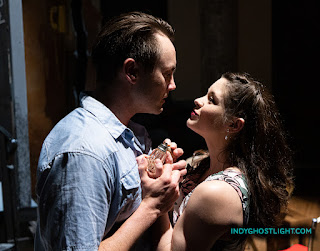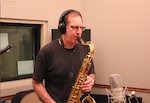IndyFringe Festival wrapup: The executive director looks back — and ahead
Looking at a new contribution to local culture from the perspective of 10 years, Pauline Moffat sees
the one she has led from the beginning as part of the mainstream.
That may seem to challenge the very name of her enterprise: IndyFringe, whose signature event started life 10 Augusts ago as the Indianapolis Theatre Fringe Festival. Though the "fringe" image may still apply to aspects of its sometimes avant-garde and raunchy entertainment, IndyFringe now makes a firm claim to having added to downtown Indianapolis' cultural stature.
"I believed it would take us 10 years for us to be seen as part of the culture," Moffat told me Wednesday. Extraordinary sponsorship came this year from BMO Harris Bank (festival naming rights) and Indy Eleven Soccer (a new theater and "Trailhead" facility). "Once you've hit that point in terms of exposure and the numbers who've come to the festival," said Moffat, such support emerges.
Moffat says that year-round programming has also built credibility with funding sources, in addition to having provided training grounds and continuing opportunities for IndyFringe's public to remain connected.
"The more you work, the more you want to rehearse and put on shows," Moffat said of the fledgling groups and playwrights. Twenty-three percent of all festival shows last year were written by women, she added, pointing to the annual DivaFest as a prime generator of new female talent.
Audiences were urged to fill out one-page surveys at every 2014 show. From over 1,000 returned, Fringe learned that 58 percent of its audience came from Marion County, 16 percent from outside the metropolitan area. The rest traveled from the counties surrounding Marion. From the same questionnaires, Moffat learned that 8.4 percent of the attendees were black, an increase that can be attributed in part to the presence on the schedule of three African-American shows.
This kind of diversity helps keep funders happy, Moffat noted, but age diversity is also very important. It helped bring BMO Harris on board as the festival's title sponsor this year. "We covered that whole range, and they went in on it because of that young-old spectrum."
That also raises the question of gauging suitability of the 64 Fringe shows, as "family-friendly" offerings help the image and the bottom line. Every year, participants are asked to provide warnings about such matters as violence, loud noises, strobe lights and "adult language" in their shows; these are printed in the program book, along with showtimes and one-paragraph descriptions. A problem that arises is that often the content of participants' shows hasn't been set by the time they're admitted (the window for 2015 participants, for example, is Nov. 1 to Feb. 28).
But sometimes mild or no warnings can be traceable to the desire to attract maximum audiences. Why warn off any paying patron? presenters figure. "All of the performers could have been stretching, and we got some of them to adjust," Moffat said. "We went to everyone that put 'family-friendly' on their shows and asked why they were going family-friendly."
Moffat said the festival will become more strict about this in years to come; otherwise, "you get a backlash with people who don't trust the warnings."
This was the first year that "backer buttons" were not required. Formerly, one-time-only purchase of these buttons (at first, $3; more recently, $5) was a prerequisite to purchase of any show ticket. Backer-button sales failed to support the festival adequately, however, so the standard show price was boosted to $15, with a small portion underwriting the festival itself.
Advance ticket sales, now in their fourth year, helped boost attendance to 16,500, with box-office receipts totaling $137,000. Forty-three percent of all ticket sales were made in advance; no portion of seats was held out to accommodate walk-up sales, she said, which made Fringe volunteers happy.
"If we are going to sell in advance, we might as well sell them all off," Moffat explained. "This was the year of customer service, and we wanted that to be part of customer service. We listened to focus groups that said, 'We want to buy tickets online.'
Meanwhile, Moffat, heading a two-person staff with a host of community support, is looking forward to the January opening of the Trailhead facility. The expansion of Fringe headquarters will include a new theater named for the Indy Eleven, open in time for the annual Winter Magic Festival. And come next summer, that new facility will be the home of the festival's eighth stage, which has moved around the neighborhood annually up to now. "I've reached the end of my tether, so I'll be delighted," Moffat said candidly. "One more permit, and we're ready to go."
Then Fringe will have moved another step closer to being off the fringe and closer to the center of the tapestry. In the decade to come? "To keep growing and keep improving," Moffat said. "We have to start succession planning and get a good solid business base in the next 10 years."
 |
| Pauline Moffat has guided IndyFringe from the start. |
That may seem to challenge the very name of her enterprise: IndyFringe, whose signature event started life 10 Augusts ago as the Indianapolis Theatre Fringe Festival. Though the "fringe" image may still apply to aspects of its sometimes avant-garde and raunchy entertainment, IndyFringe now makes a firm claim to having added to downtown Indianapolis' cultural stature.
"I believed it would take us 10 years for us to be seen as part of the culture," Moffat told me Wednesday. Extraordinary sponsorship came this year from BMO Harris Bank (festival naming rights) and Indy Eleven Soccer (a new theater and "Trailhead" facility). "Once you've hit that point in terms of exposure and the numbers who've come to the festival," said Moffat, such support emerges.
Moffat says that year-round programming has also built credibility with funding sources, in addition to having provided training grounds and continuing opportunities for IndyFringe's public to remain connected.
"The more you work, the more you want to rehearse and put on shows," Moffat said of the fledgling groups and playwrights. Twenty-three percent of all festival shows last year were written by women, she added, pointing to the annual DivaFest as a prime generator of new female talent.
Audiences were urged to fill out one-page surveys at every 2014 show. From over 1,000 returned, Fringe learned that 58 percent of its audience came from Marion County, 16 percent from outside the metropolitan area. The rest traveled from the counties surrounding Marion. From the same questionnaires, Moffat learned that 8.4 percent of the attendees were black, an increase that can be attributed in part to the presence on the schedule of three African-American shows.
This kind of diversity helps keep funders happy, Moffat noted, but age diversity is also very important. It helped bring BMO Harris on board as the festival's title sponsor this year. "We covered that whole range, and they went in on it because of that young-old spectrum."
That also raises the question of gauging suitability of the 64 Fringe shows, as "family-friendly" offerings help the image and the bottom line. Every year, participants are asked to provide warnings about such matters as violence, loud noises, strobe lights and "adult language" in their shows; these are printed in the program book, along with showtimes and one-paragraph descriptions. A problem that arises is that often the content of participants' shows hasn't been set by the time they're admitted (the window for 2015 participants, for example, is Nov. 1 to Feb. 28).
 |
| Artist's conceptual rendering of IndyFringe's Trailhead facility. |
Moffat said the festival will become more strict about this in years to come; otherwise, "you get a backlash with people who don't trust the warnings."
This was the first year that "backer buttons" were not required. Formerly, one-time-only purchase of these buttons (at first, $3; more recently, $5) was a prerequisite to purchase of any show ticket. Backer-button sales failed to support the festival adequately, however, so the standard show price was boosted to $15, with a small portion underwriting the festival itself.
Advance ticket sales, now in their fourth year, helped boost attendance to 16,500, with box-office receipts totaling $137,000. Forty-three percent of all ticket sales were made in advance; no portion of seats was held out to accommodate walk-up sales, she said, which made Fringe volunteers happy.
"If we are going to sell in advance, we might as well sell them all off," Moffat explained. "This was the year of customer service, and we wanted that to be part of customer service. We listened to focus groups that said, 'We want to buy tickets online.'
Meanwhile, Moffat, heading a two-person staff with a host of community support, is looking forward to the January opening of the Trailhead facility. The expansion of Fringe headquarters will include a new theater named for the Indy Eleven, open in time for the annual Winter Magic Festival. And come next summer, that new facility will be the home of the festival's eighth stage, which has moved around the neighborhood annually up to now. "I've reached the end of my tether, so I'll be delighted," Moffat said candidly. "One more permit, and we're ready to go."
Then Fringe will have moved another step closer to being off the fringe and closer to the center of the tapestry. In the decade to come? "To keep growing and keep improving," Moffat said. "We have to start succession planning and get a good solid business base in the next 10 years."



Comments
Post a Comment